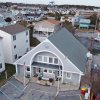Arbor Day puts focus on Lewes trees
It was just one tree, but a willow oak planted on Arbor Day was a symbol of Lewes’ desire to grow its tree canopy.
“I’m trying to plant as many trees as I can,” said Mardi Thompson, Lewes tree commissioner. “This is a step in the process of improving our canopy.”
She joined other city leaders on the morning of April 26 as Sussex Tree - SavATree planted the willow oak at the Lewes-to-Georgetown Trail trailhead at Monroe Avenue and Freeman Highway.
“This is a great site for a tree,” said Jeremy Ayars, certified arborist with Sussex Tree - SavATree. “It’s going to be 8 feet tall. It’s going to provide shade and nourishment to the ecosystem, and it’s going to provide beauty.”
Engineers from George, Miles & Buhr, the city’s engineer, recently unveiled a website that establishes the city’s baseline tree canopy percentage. The link can be found at arcgis.com.
The website shows the tree canopy peaked at 18.3% in 2016, but dropped to 17.4% in 2021, the most recent year the data covers.
At the April 25 mayor and city council workshop, planning commissioner Debra Evalds, who was a member of the now-defunct Lewes Tree Subcommittee, said she finds the decline troubling.
“We have done some things with annexation that should have [led to] some increases here. But instead, it kept it steady,” she said. “The city plants trees every year. It’s not adding. What we’re doing is not enough.”
The tree canopy issue has been remanded back to the planning commission’s environmental subcommittee for further discussion.
GMB engineer Charlie O’Donnell said a goal of growing the tree canopy at 5% over 10 years would be a reasonable starting point for the subcommittee.
Amy Marasco, subcommittee chair and soon-to-be city councilperson, said the issue of trees was the No. 1 category on an environmental tapestry she helped create.
Marasco officially presented the tapestry to mayor and city council April 25. It is now hanging in council chambers. The tapestry is made up of 500 felt footprints sewn together, each with an environmental message for the city. Marasco and city staff spent last summer having children and adults fill out the footprints.
“The two most serious environmental areas we have to address are flooding and heat. Trees are a critical part of that,” Marasco said.
Marasco said the messages encourage the city to save, plant and protect more trees.


Bill Shull has been covering Lewes for the Cape Gazette since 2023. He comes to the world of print journalism after 40 years in TV news. Bill has worked in his hometown of Philadelphia, as well as Atlanta and Washington, D.C. He came to Lewes in 2014 to help launch WRDE-TV. Bill served as WRDE’s news director for more than eight years, working in Lewes and Milton. He is a 1986 graduate of Penn State University. Bill is an avid aviation and wildlife photographer, and a big Penn State football, Eagles, Phillies and PGA Tour golf fan. Bill, his wife Jill and their rescue cat, Lucky, live in Rehoboth Beach.






















































